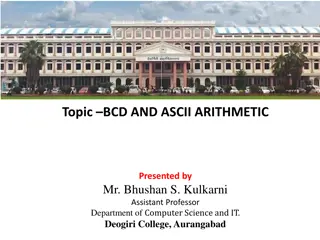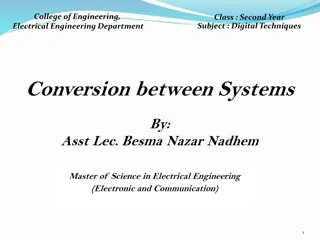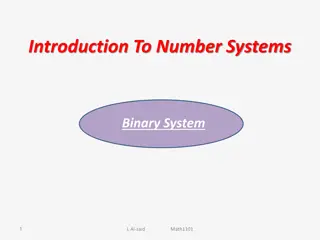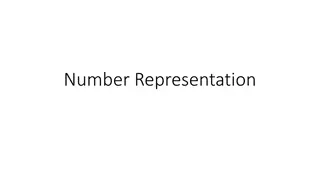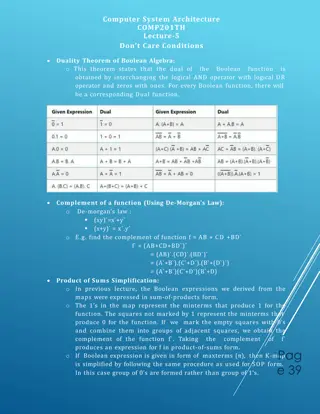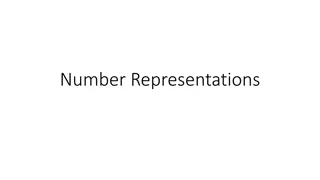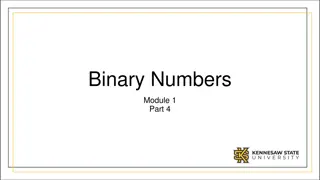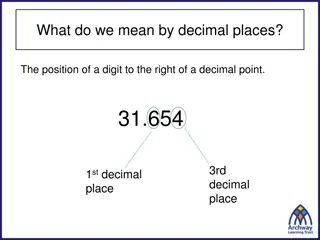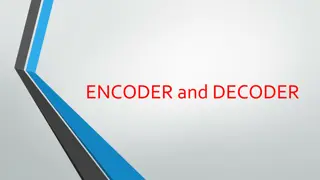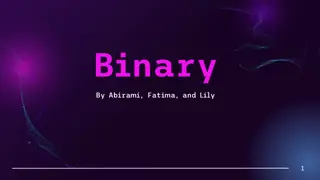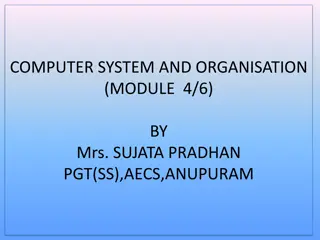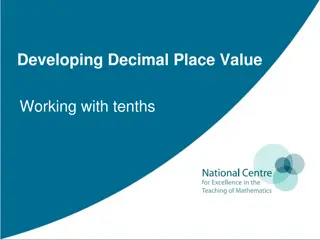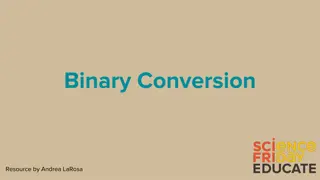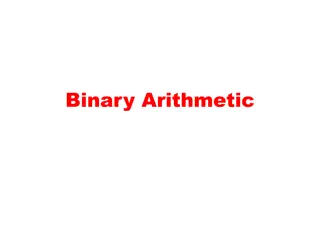Understanding Binary Coded Decimal (BCD) and Excess-3 Code
Binary Coded Decimal (BCD) is a binary code used to represent decimal numbers, with the popular 8421 BCD code and its conversion process explained. Additionally, Excess-3 Code, another BCD code, is detailed with an example of finding its code for a given decimal number. Different BCD codes like 4221 and 5421 are compared, providing insights into their weighted representations. The comprehensive explanation covers conversions between binary and BCD forms, aiding in understanding digital techniques in electrical engineering.
Download Presentation

Please find below an Image/Link to download the presentation.
The content on the website is provided AS IS for your information and personal use only. It may not be sold, licensed, or shared on other websites without obtaining consent from the author. Download presentation by click this link. If you encounter any issues during the download, it is possible that the publisher has removed the file from their server.
E N D
Presentation Transcript
College of Engineering, Electrical Engineering Department Class : Second Year Subject : Digital Techniques Binary Coded By: Asst Lec. Besma Nazar Nadhem Master of Science in Electrical Engineering (Electronic and Communication) 1
Binary Coded Decimal (BCD) is a type of binary code used to represent a given decimal number in an equivalent binary form. The BCD equivalent of a decimal number is written by replacing each decimal digit in the integer and fractional parts with its four-bit binary equivalent. The BCD code described above is more precisely known as the 8421 BCD code . As an example, the BCD equivalent of (23.15)10 is written as (0010 0011.0001 0101)BCD A given BCD number can be converted into an equivalent binary number by first writing its decimal equivalent and then converting it into its binary equivalent
Example: find the binary equivalent of the BCD number 0010 1001.0111 0101 Solution : .BCD number: 0010 1001.0111 0101. Corresponding decimal number: 29.75. The binary equivalent of 29.75 can be determined to be 11101 for the integer part and .11 for the fractional part. Therefore, (0010 1001.0111 0101)BCD =(11101.11)2. code is the most popular of all the BCD codes, it is simply referred to as the BCD code. The process of binary-to-BCD conversion is the same as the process of BCD-to-binary conversion executed in reverse order. A given binary number can be converted into an equivalent BCD number by first determining its decimal equivalent and then writing the corresponding BCD equivalent.
Example: find the BCD equivalent of the binary number 10101011.101: Solution : The decimal equivalent of this binary number can be determined to be 171.625. The BCD equivalent can then be written as 0001 0111 0001.0110 0010 0101. Other Decimal Codes Other weighted BCD codes include the 4221 BCD and 5421 BCD codes. Again, 4, 2, 2 and 1 in the 4221 BCD code and 5, 4, 2 and 1 in the 5421 BCD code represent weights of the relevant bits. Table 2.1 shows a comparison of 8421, 4221 and 5421 BCD codes. As an example, (98.16)10 will be written as 1111 1110.0001 1100 in 4221 BCD code and 1100 1011.0001 1001 in 5421 BCD code. Since the 8421
Excess-3 Code The excess-3 code is another important BCD code. The excess- 3 code for a given decimal number is determined by adding 3 to each decimal digit in the given number and then replacing each digit of the newly found decimal number by its four-bit binary equivalent. Example: find the excess-3 code for the decimal number 597 Solution: The addition of 3 to each digit yields the three new digits/numbers 8 , 12 and 10 . The corresponding four-bit binary equivalents are 1000, 1100 and 1010 respectively. The excess-3 code for 597 is therefore given by: 1000 1100 1010=100011001010.
Gray Code It is an unweighted binary code in which two successive values differ only by 1 bit. Owing to this feature, the maximum error that can creep into a system using the binary Gray code to encode data is much less than the worst-case error encountered in the case of straight binary encoding. Binary Gray Code Conversion 1. Begin with the most significant bit (MSB) of the binary number. The MSB of the Gray code equivalent is the same as the MSB of the given binary number. 2. The second most significant bit, adjacent to the MSB, in the Gray code number is obtained by adding the MSB and the second MSB of the binary number and ignoring the carry, if any. That is, if the MSB and the bit adjacent to it are both 1 , then the corresponding Gray code bit would be a 0 . 3. The third most significant bit, adjacent to the second MSB, in the Gray code number is obtained by adding the second MSB and the third MSB in the binary number and ignoring the carry, if any. 4. The process continues until we obtain the LSB of the Gray code number by the addition of the LSB and the next higher adjacent bit of the binary number.
The conversion process is further illustrated with the help of an example showing step-by-step conversion of (1011)2 into its Gray code equivalent: Binary 1011 Gray code 1- - - Binary 1011 Gray code 11- - Binary 1011 Gray code 111- Binary 1011 Gray code 1110
A given Gray code number can be converted into its binary equivalent by going through the following steps: 1. Begin with the most significant bit (MSB). The MSB of the binary number is the same as the MSB of the Gray code number. Gray Code Binary Conversion 2. The bit next to the MSB (the second MSB) in the binary number is obtained by adding the MSB in the binary number to the second MSB in the Gray code number and disregarding the carry, if any. 3. The third MSB in the binary number is obtained by adding the second MSB in the binary number to the third MSB in the Gray code number. Again, carry, if any, is to be ignored. 4. The process continues until we obtain the LSB of the binary number.
The conversion process is further illustrated with the help of an example showing step-by-step conversion of the Gray code number 1110 into its binary equivalent: Gray code 1110 Binary1- - - Gray code 1110 Binary10 - - Gray code 1110 Binary101 Gray code 1110 Binary1011


